This article needs additional citations for verification .(February 2012) |
Fredelsloh Abbey is a former monastery in Fredelsloh, district Northeim, Germany.
This article needs additional citations for verification .(February 2012) |
Fredelsloh Abbey is a former monastery in Fredelsloh, district Northeim, Germany.
It was founded by Adalbert, archbishop of Mainz in 1132. At first, Augustinian Canons lived there, but by about 1145 a switch to a double monastery took place, so that from then on nuns lived there as well. As it lay in the northern boundary region of their territory, the bishops authorized the counts of Dassel to act as their vogts until 1277. Soon thereafter, the canons left the monastery.
It ceased to exist about one century after the Protestant Reformation, soon after the Thirty Years' War. The buildings were demolished with the exception of the church, which was used for crop storage until the Evangelical-Lutheran Church of Hanover resumed church service in the 20th century.

The church is a well-preserved example of Romanesque architecture. It is a basilica with two towers, built of reddish ashlar sandstone. Right below the gable roof, lombard bands decorate the outer walls. The northern portal nowadays serves as entrance, its masonry arch dating back to the 1130s, thus one of the oldest true arches in Germany.
A unique double helix circular stairs is one of the architectural highlights but not publicly accessible due to a supporting wall that was built in the 17th century. These stairs are classified as 13th-century work, the builder most likely stemming from the Levant region. One of the counts of Dassel had participated in the Third Crusade.
Remarkable masonry reliefs of the apostles are placed in the choir.

Romanesque architecture is an architectural style of medieval Europe that was predominant in the 11th and 12th centuries. The style eventually developed into the Gothic style with the shape of the arches providing a simple distinction: the Romanesque is characterized by semicircular arches, while the Gothic is marked by the pointed arches. The Romanesque emerged nearly simultaneously in multiple countries ; its examples can be found across the continent, making it the first pan-European architectural style since Imperial Roman architecture. Similarly to Gothic, the name of the style was transferred onto the contemporary Romanesque art.
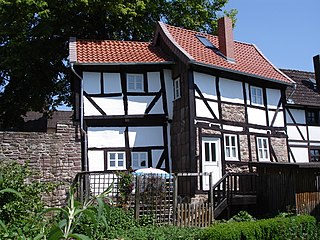
Dassel is a town in southern Lower Saxony, Germany, located in the district Northeim. It is located near the hills of the Solling mountains.
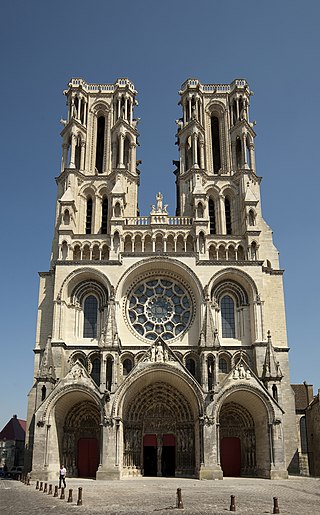
Laon Cathedral is a Roman Catholic church located in Laon, Aisne, Hauts-de-France, France. Built in the twelfth and thirteenth centuries, it is one of the most important and stylistically unified examples of early Gothic architecture. The church served as the cathedral of the Diocese of Laon until 1802, and has been recognized as a monument historique since 1840.

Noravank is a 13th-century Armenian monastery, located 122 km from Yerevan in a narrow gorge made by the Amaghu River, near the town of Yeghegnadzor in Armenia. The gorge is known for its tall, sheer, brick-red cliffs, directly across from the monastery. The monastery is best known for its two-storey Surb Astvatsatsin Church, which grants access to the second floor by way of a narrow stone-made staircase jutting out from the face of building.
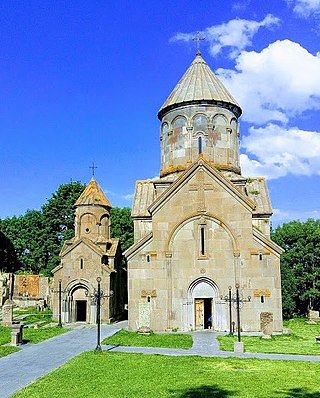
Kecharis Monastery, is a medieval Armenian monastic complex dating back to the 11th to 13th centuries, located 60 km from Yerevan, in the ski resort town of Tsaghkadzor in Armenia. Nestled in the Pambak mountains, Kecharis was founded by a Pahlavuni prince in the 11th century, and construction continued until the middle of the 13th century with its acquisition by the Proshian family. In the 12th and 13th centuries, Kecharis was a major religious center of Armenia and a place of higher education. Today, the monastery has been fully restored and is clearly visible from the ski slopes.

Børglum Abbey was an important Premonstratensian abbey of medieval Denmark, located in Børglum parish, in the commune of Hjørring, approximately five kilometers east of Løkken in north central Jutland from the 12th century until reformation.

Sanahin Monastery is an Armenian monastery founded in the 10th century in Sanahin in the Lori Province of Armenia.

All Saints' Church in Wing, Buckinghamshire, is a Grade I listed parish church. Its masonry was largely built in the 8th to 11th centuries during the Anglo-Saxon period, making it one of the oldest surviving churches in England.

Souagui is a town and commune in Médéa Province, Algeria. According to the 1998 census, it has a population of 19,059.
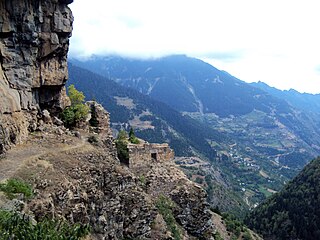
Parekhi is a Georgian medieval Orthodox monastery in historical Medieval Georgian Kingdom of Klarjeti.

Romanesque architecture is an architectural style of medieval Europe characterised by semi-circular arches. The term "Romanesque" is usually used for the period from the 10th to the 12th century with "Pre-Romanesque" and "First Romanesque" being applied to earlier buildings with Romanesque characteristics. Romanesque architecture can be found across the continent, diversified by regional materials and characteristics, but with an overall consistency that makes it the first pan-European architectural style since Imperial Roman Architecture. The Romanesque style in England is traditionally referred to as Norman architecture.

The Priory of Saint-Martin-des-Champs was an influential monastery established in what is now the city of Paris, France. Its surviving buildings are considered treasures of Medieval architecture in the city.

Romanesque architecture in Spain is the architectural style reflective of Romanesque architecture, with peculiar influences both from architectural styles outside the Iberian Peninsula via Italy and France as well as traditional architectural patterns from within the peninsula. Romanesque architecture was developed in and propagated throughout Europe for more than two centuries, ranging approximately from the late tenth century until the thirteenth century.

Bellapais Abbey is the ruin of a monastery built by Canons Regular in the 13th century on the northern side of the small village of Bellapais, now in Turkish-controlled Northern Cyprus, about five kilometres from the town of Kyrenia. The ruin is at an altitude of 220 m above sea level, and commands a long view down to Kyrenia and the Mediterranean sea.
Lüthorst is a village in Lower Saxony. It is a suburb of Dassel and was incorporated into this city in 1974. It is located between the Amtsberge and the Elfas hills.

St. Patrokli is a Roman Catholic parish and church in Soest, Germany. The church is of great significance in the history of architecture as it is the epitome of Romanesque architecture in Westphalia. As a result, it is known as St.-Patrokli-Dom. It holds relics of its patron saint Patroclus of Troyes from 954. It was the church of the canonical foundation of St. Patroclus, which existed from the 10th century until its abolition in 1812. Since 1823 the church has been the parish church of the St. Patrokli parish in the diocese of Paderborn. In 1859 it was promoted to the rank of provost church.

St Mary's Church is a heritage-listed Roman Catholic church at 20 Merivale Street, South Brisbane, Queensland, Australia. It was designed by Simkin and Ibler and built from 1892 to 1929. It was added to the Queensland Heritage Register on 3 December 2004.
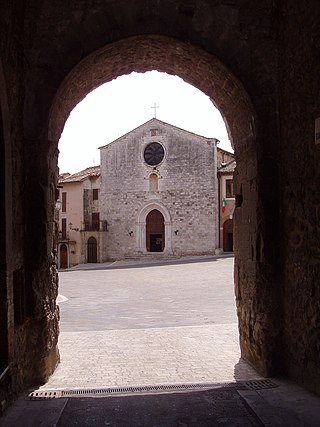
San Francesco is a Gothic-style, Roman Catholic, church in a piazza of the same name in the town of San Gemini, region of Umbria, Italy. The 13-14th-century church was erected by the Franciscan order and dedicated to St Francis, who visited the town at least twice in his lifetime.

Mar Yakov Church or Mor Yakup Church, also known as the Church of Saint Jacob in Nisibis, is a historic church in Nusaybin, southeastern Turkey. Archaeological excavations revealed that the 4th-century church building was originally the baptistery of a cathedral, which no longer exists. It is not determined whether this church belonged to Syriac Orthodox Church or the Church of the East, but it is under the jurisdiction of the Syriac Orthodox Church which it is most likely linked to.